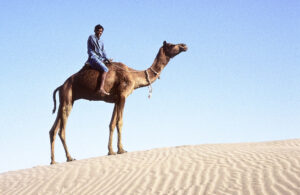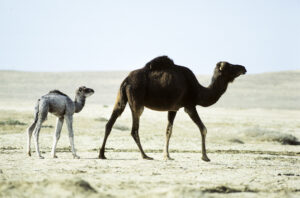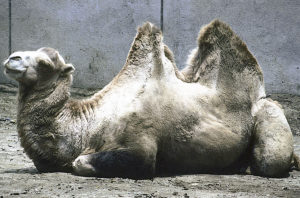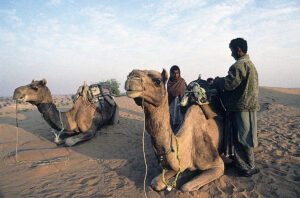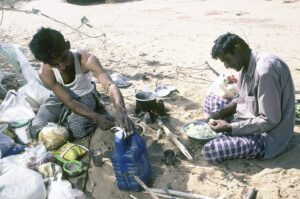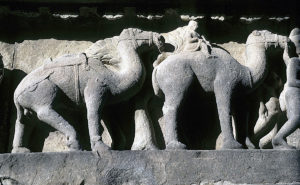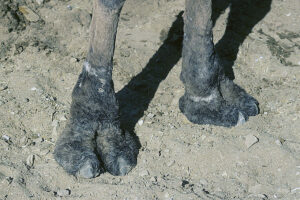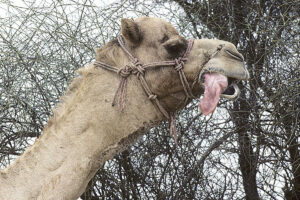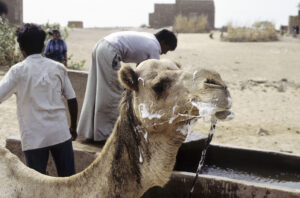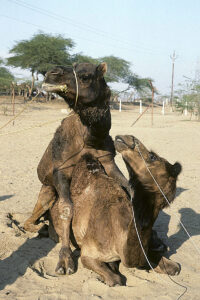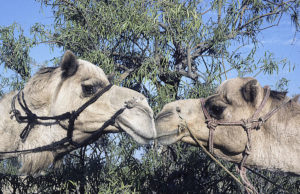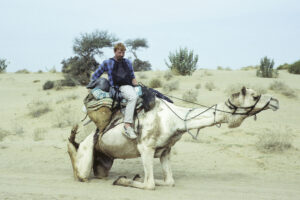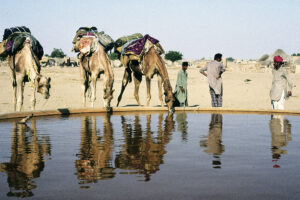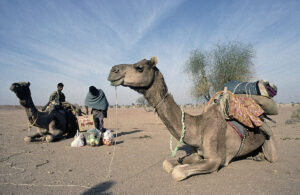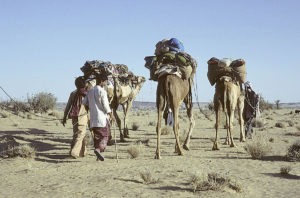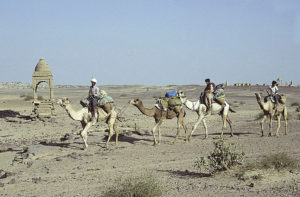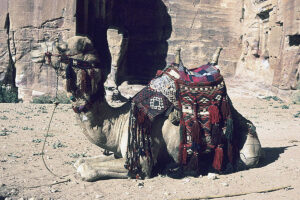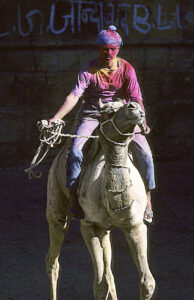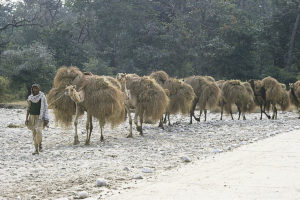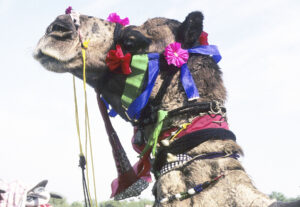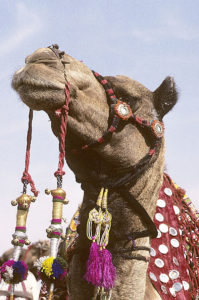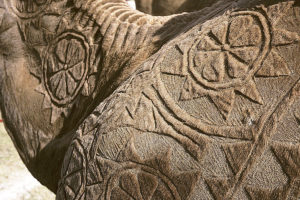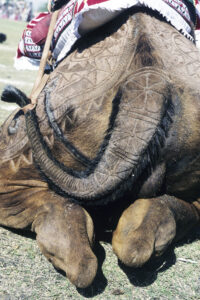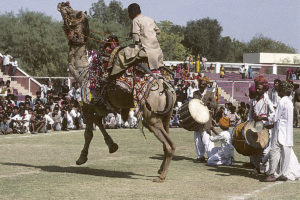Camels
The dromedary, or one-humped camel (Camelus dromedarius), was probably first domesticated around 3000 B.C. – Camel riders, Thar Desert, Rajasthan, India. The children have smeared a paste on their faces as a protection against the fierce sun. (Photos copyright © by Kaj Halberg)
A dromedary and her foal, between Tozeur and Tamerza, Tunisia. (Photo copyright © by Kaj Halberg)
The Bactrian, or two-humped camel (Camelus bactrianus), was probably domesticated around 2500 B.C. – Chengdu Zoo, Sichuan Province, China. (Photo copyright © by Kaj Halberg)
”Shortly before dusk, we make camp. The baggage is unloaded, and our blankets are rolled out in the sand. No need for tents here, as the risk of rain is next to none. However, nights in the desert are rather cold, so my sleeping bag is of good use.
Jamset and Dina collect a few dead branches from nearby trees, light a fire and start preparing our evening meal. Meanwhile, I am seated, leaning against a camel’s soft body, watching the flickering fire, while the camels are chewing their cud, their neck bells tinkling softly. While cooking, my camel drivers sing sad songs about love or precious rain.
The night is wonderful. To lie snug in your sleeping bag on the soft desert sand, under a thousand twinkling stars, and maybe a falling star or a moving satellite, is indeed meditative.”
Quote from Travel episodes – India 2003: Camel safari in the Thar Desert (see elsewhere on this website).
“Shortly before dusk, we make camp, and Jamset and Dina start preparing our evening meal.” (Photos copyright © by Kaj Halberg)
Ancestry of camels
The earliest known camelid, Protylopus, which lived in North America 40 to 50 million years ago, was about the size of a rabbit. About 10 million years later, other camelids had evolved, including Poebrotherium, an animal the size of a goat and somewhat resembling today’s camels and llamas.
The direct ancestor of modern camels, Procamelus, lived around 5 million years ago, spreading to South America via the newly formed Isthmus of Panama, where it evolved into the llama, the guanaco, and the vicuña, and via a Bering land bridge to Asia, where it evolved into true camels.
The last native camel in North America was Camelops hesternus, which, together with a host of other animals, such as mastodon, saber-toothed cat, and horse, in all probability were extirpated by nomadic hunters, which had migrated here via the latest Bering land bridge, about 12,000 years ago.
Today’s camels
The true camels, which evolved in Asia, are characterized by their distinctive fatty deposits on their back, called the hump. Three species are recognized.
The dromedary, or one-humped camel (Camelus dromedarius), is extinct in the wild, but is widely distributed as a domestic animal, from India across the Middle East to the Arabian Peninsula, Egypt, Somalia, and northern Kenya. It was probably first domesticated around 3000 B.C. in Somalia or southern Arabia.
The Bactrian, or two-humped camel (Camelus bactrianus), which is also extinct in the wild, is found in the Central Asian highlands and Iran, but in much lower numbers than the dromedary. The first domestication of this species in Central Asia is believed to have taken place around 2500 B.C.
These two species are closely related, as they are able to interbreed and produce fertile offspring. A widely accepted theory today is that they both evolved from a third species, the wild Bactrian camel (Camelus ferus), of which a few scattered herds live in Mongolia, Xinjiang, and Tibet, the total population probably counting fewer than a thousand individuals. It is thus critically endangered and may soon go extinct.
This frieze in the Lakshmana Temple, Khajuraho, Madhya Pradesh, India, depicting camels, was carved around 1000 A.D. (Photo copyright © by Kaj Halberg)
Camels are ruminants. This camel in the Thar Desert, Rajasthan, is chewing the cud. (Photo copyright © by Kaj Halberg)
Camels have broad, flat, leathery pads under their feet – an adaptation to avoid sinking into soft sand. (Photo copyright © by Kaj Halberg)
In winter, when she camels in Rajasthan are in heat, bull camels in rut often emit a gargling roar, blowing up their tongue and letting it hang out of the mouth, smeared in white or pink saliva, which is flying all over the place. Our camel drivers made this comment: “The camel is sexy.” (Photos copyright © by Kaj Halberg)
The gestation period of camels are 360 to 420 days. This picture shows mating dromedaries at a breeding centre for camels in Bikaner, Rajasthan. (Photo copyright © by Kaj Halberg)
Dromedary foals are all skinny legs. The weight of a newborn foal varies between 35 and 40 kilograms. – Bikaner. (Photo copyright © by Kaj Halberg)
Dromedaries are often very affectionate. (Photo copyright © by Kaj Halberg)
Søren Lauridsen as camel rider. When a camel gets up, it first rises halfway on its hindlegs, and you are thrown forward. Next, it rises on its forelegs, and you are thrown backward. Finally, it rises completely on its hind-legs, making you slide forward again. If you don’t have a firm grip on the saddle, you may easily fall off. (Photo copyright © by Kaj Halberg)
Successful domestication
The reason for the successful survival of camels as domesticated animals lies in their ability to thrive in areas with a hot and dry climate, being able to survive for long periods of time without access to drinking water. Thus, they were very useful for transporting goods across deserts.
Camels can lose a third of their body weight due to dehydration without any harm. When they do have access to water, they are able to drink an unbelievable amount of it. It has been recorded that one camel, weighing about 600 kg, drank about 200 litres in a few minutes. Camels do not store water in their hump as was formerly believed. The hump is fatty tissue, and the reason for the storage of fat here is that the animal is better able to withstand a hot climate without an insulating layer of fat distributed over the entire body.
Besides being pack animals, which transport goods and people, camels provide meat and milk, bags are produced from their skin, and textiles from their fur. A former, rather special utilization of the dromedary was camel cavalries, used by armed forces in desert warfare, mostly as a means of transportation, as horses didn’t thrive in these dry conditions. Fighting also sometimes took place from camel-back, initially with spears and bows, and later with rifles.
In the Indian state of Rajasthan, Raikas are a special caste of camel breeders, who believe that they were created by Shiva to be camel guardians. They worship the camel god Prabuji.
Camels can lose a third of their body weight due to dehydration without any harm. When they do have access to water, they are able to drink an unbelievable amount of it. – Thar Desert. (Photo copyright © by Kaj Halberg)
At an early stage, camels were used for transporting goods across deserts. These pictures are from the Thar Desert, Rajasthan. (Photos copyright © by Kaj Halberg)
This dromedary in the city of Jaipur, Rajasthan, is pulling a cart, laden with yarn. (Photo copyright © by Kaj Halberg)
Camel caravans are history, but you can get a feel of the daily life of caravans by going on a camel safari. This picture was taken during a safari in the Thar Desert. (Photo copyright © by Kaj Halberg)
Dromedary, dressed up for transporting tourists, Petra, Jordan. (Photo copyright © by Kaj Halberg)
During the Hindu festival of Holi, popularly called ‘The Festival of Colours’, this camel rider in Jaisalmer, Rajasthan, has been smeared in dyed powder. (Photo copyright © by Kaj Halberg)
Decorations and graffiti on a rockwall on Mount Girnar, Junagadh, Gujarat, India, a sacred mountain to Jains. A tile, which depicts a goddess riding on a camel, has been glued to the rock. (Photo copyright © by Kaj Halberg)
Gujjars
The Gujjars are a tribe of pastoral Muslim nomads, who live in the north-western part of the Himalaya. These people use camels as a means of transportation.
Although the Rajaji area in Uttarakhand was declared a national park in 1993, the Gujjars still live here. Foresters have pointed out that these people should be banned from grazing their animals in the park, but, ironically, they seem to benefit wildlife here, as they keep poachers away from the area. For instance, the number of wild Asian elephants (Elephas maximus) in the park has increased in later years. The Gujjars themselves do not harm wildlife, as they are vegetarians.
The camels of this Gujjar, encountered in Rajaji National Park, are laden with huge bundles of hay. (Photo copyright © by Kaj Halberg)
Camel festivals
Such festivals are held annually several places in the Thar Desert, Rajasthan. The pictures below were taken during a festival in the town of Bikaner.
Decorated dromedaries. (Photos copyright © by Kaj Halberg)
Elaborate patterns have been cut in the fur of these camels. (Photos copyright © by Kaj Halberg)
Tassels are hanging down from the tail of this camel, and tiny bells have been tied to its legs. (Photo copyright © by Kaj Halberg)
During a camel festival, music and dancing camels are a part of the entertainment. (Photo copyright © by Kaj Halberg)
How many people can a dromedary carry? (Photo copyright © by Kaj Halberg)
(Uploaded September 2017)
(Latest update October 2024)
